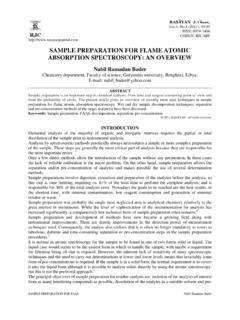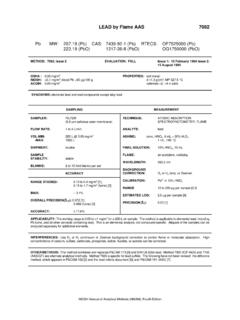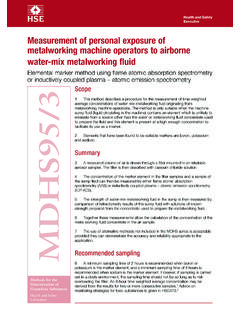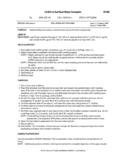Transcription of ALUMINIUM POTASSIUM SULFATE - fao.org
1 ALUMINIUM POTASSIUM SULFATE Prepared at the 55th JECFA (2000) and published in FNP 52 Add 8 (2000), superseding tentative specifications prepared at the 22nd JECFA (1978) and published in FNP 7 (1978) and in FNP 52 (1992). No ADI was allocated at the 22nd JECFA (1978). SYNONYMS POTASSIUM alum, potash alum Burnt alum (anhydrous) INS No. 522 (dodecahydrate) DEFINITION Chemical names ALUMINIUM POTASSIUM SULFATE dodecahydrate ALUMINIUM POTASSIUM SULFATE anhydrous number 7784-24-9 (dodecahydrate) 10043-67-1 (anhydrous) Chemical formula AlK(SO4)2 xH2O (x = 0 or 12) Formula weight (dodecahydrate) (anhydrous) Assay Dodecahydrate: not less than Anhydrous form: not less than DESCRIPTION Large, transparent crystals or crystalline fragments, or white crystalline powder.
2 Odourless FUNCTIONAL USES Acidity regulator, firming agent, raising agent CHARACTERISTICS IDENTIFICATION Solubility (Vol. 4) Freely soluble in water; insoluble in ethanol pH (Vol. 4) - (10% solution) Test for ALUMINIUM Passes test Determine using an atomic absorption technique appropriate to the specified level. The selection of sample size and method of sample preparation may be based on the principles of the method described in Volume 4, Instrumental Methods. Test for SULFATE (Vol. 4) Passes test Test for POTASSIUM (Vol.)
3 4 ) Passes test PURITY Ammonium salts Heat 1 g of the sample with 10 ml of sodium hydroxide TS on a steam bath for 1 min. The odour of ammonia is not perceptible. Fluoride Not more than 30 mg/kg See description under TESTS Lead Not more than 5 mg/kg Determine using an atomic absorption technique appropriate to the specified level. The selection of sample size and method of sample preparation may be based on the principles of the method described in Volume 4, Instrumental Methods. Selenium (Vol. 4) Not more than 30 mg/kg Test g of the sample as directed in the Limit Test (Method II).
4 TESTS PURITY TESTS Fluoride Lime Suspension Carefully slake about 56 g of low-fluoride calcium oxide (about 2 mg/kg F) with 250 ml of water, and add 250 ml of 60% perchloric acid slowly and with stirring. Add a few glass beads, and boil to copious fumes of perchloric acid, then cool, add 200 ml of water, and boil again. Repeat the dilution and boiling once more, cool, dilute considerably, and filter through a fritted glass filter, if precipitated silicon dioxide appears. Pour the clear solution, with stirring, into 1000 ml of a 1 in 10 sodium hydroxide solution, allow the precipitate to settle, and siphon off the supernatant liquid.
5 Remove the sodium salts from the precipitate by washing 5 times in large centrifuge bottles, shaking the mass thoroughly each time. Finally, shake the precipitate into a suspension and dilute to 2000 ml. Store in paraffin-lined bottles and shake well before use. 100 ml of this suspension should give no appreciable fluoride blank when evaporated in a platinum dish and treated as directed below under "Procedure", beginning with "Ignite briefly at " Distillation Apparatus Connect a 125-ml distillation flask with a condenser. Equip also with a thermometer and a capillary tube, both of which must extend into the liquid.
6 Connect a small dropping funnel or a steam generator to the capillary tube. Support the flask on an asbestos mat with a hole, which exposes about one-third of the flask to the flame. To minimize the distillation blank resulting from fluoride leached from the glassware, the distillation apparatus should be treated as follows: treat the glassware with hot 10% sodium hydroxide solution, followed by flushing with tap water and rinsing with distilled water. At least once daily, treat in addition by boiling down 15-20 ml of a 1 in 2 sulfuric acid solution until the still is filled with fumes; cool, pour off the acid, treat again with 10% sodium hydroxide solution, and rinse thoroughly.
7 Procedure Add to the distilling flask g of the sample, accurately weighed, and 25 ml of a 1 in 2 sulfuric acid solution. Distil until the temperature reaches 160o, then maintain at 160o to 165o by adding water from the funnel, collecting 300 ml of distillate. Oxidize the distillate by the cautious addition of 2 or 3 ml of fluoride-free 30% hydrogen peroxide (to remove sulfites), allow to stand for a few min, and evaporate in a platinum dish with an excess of Lime Suspension. Ignite briefly at 600o, then cool and wet the ash with about 10 ml of water.
8 Cover the dish with a watch glass, and cautiously introduce under cover just sufficient 60% perchloric acid to dissolve the ash. Add the contents of the dish through the dropping funnel of a freshly treated distilling apparatus (the distilling flask should contain a few glass beads), using a total of 20 ml of 60% perchloric acid for dissolving the ash and transferring the solution. Add 10 ml of water and a few drops of a 1 in 2 silver perchlorate solution through the dropping funnel. Continue as directed in the Limit Test, Method I, Thorium Nitrate Colorimetric Method, beginning with "Distil until the temperature reaches 135o.
9 ". METHOD OF ASSAY a) Dodecahydrate form Weigh accurately about 1 g of the sample, dissolve in 50 ml of water, add ml of M disodium ethylenediamine-tetraacetate, and boil gently for 5 min. Cool, and with continuous stirring add in the order given: 20 ml of pH buffer solution ( g of ammonium acetate and 57 ml of glacial acetic acid in 1000 ml), 50 ml of ethanol, and 2 ml of dithizone TS. Titrate with M zinc SULFATE to a bright rose-pink colour, and perform a blank determination. Each ml of M disodium ethylenediamine tetraacetate is equivalent to mg of AlK(SO4)2 12H2O.
10 B) Anhydrous form Weigh accurately about g of powdered ALUMINIUM POTASSIUM SULFATE , previously dried at 200o for 4 hours. Add 100 ml of water, dissolve by heating in a water bath and shaking, filter, and wash the insoluble residue thoroughly with water. Combine the filtrate and the washings, add water to make exactly 200 ml. Measure 25 ml of this solution, add 50 ml of mol/l EDTA, and heat to boiling. Cool and add 7 ml of 14% sodium acetate solution and 85 ml of absolute ethanol. Titrate the excess EDTA with mol/l zinc acetate using 3 drops of xylenol orange TS as indicator.

















